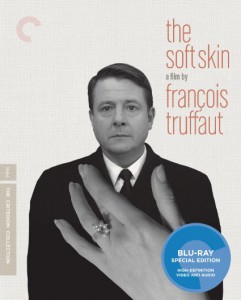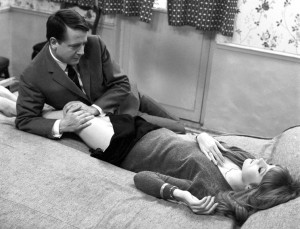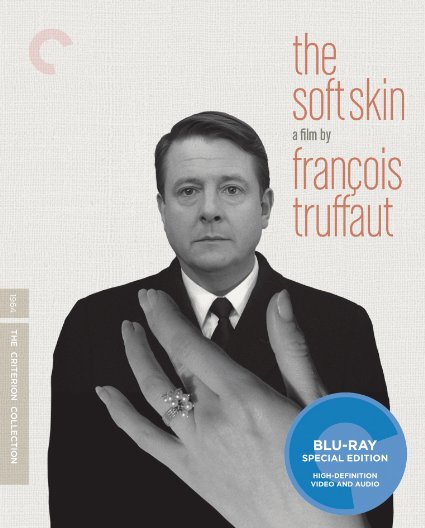
Written by François Truffaut and Jean-Louis Richard
Directed by François Truffaut
France, 1964
Riding high on the critical reputation of the French New Wave (if not its consistent box office success), and with The 400 Blows (1959), Shoot the Piano Player (1960), and Jules and Jim (1962) behind him, François Truffaut’s fourth feature is something rather different. There is still the same cinematic playfulness, a combination of genuine skill, pervasive influence, and a rampant passion for the medium itself, but with The Soft Skin (1964), Truffaut slows things down somewhat, takes a breath, matures. That’s not to say there weren’t adult themes in his earlier films (most certainly there were in Jules and Jim), but here, the entire tone of the film feels more aged, more serious, as if Truffaut was for the first time making a film explicitly for grown-ups, not just featuring them.
Nominated for the Palme d’Or at the 1964 Cannes Film Festival, The Soft Skin is nevertheless seen as one of François Truffaut’s least recognized works. And truth be told, it doesn’t hold up as well as some of his more famous features. But there’s still a lot working in its favor, from Truffaut’s own energized direction, which rarely falters, to the contributions of his key collaborators. This is one of Georges Delerue’s most diverse scores, perfectly expressing the anxiety and the doomed romanticism of the characters. Cinematographer Raoul Coutard is top notch, as usual. And frequent Truffaut editor Claudine Bouché keeps a solid pace.
 The picture begins with the same sort of frenetic pacing that kicked off Jules and Jim, as Pierre Lachenay (Jean Desailly) rushes to catch a plane. It’s a chaotic opening, with only bits of character exposition obtained sporadically here and there. We gather that Lachenay—married, with a daughter—is an academic of some renown, and he’s traveling to Lisbon to lecture on Balzac. He holds a position of popularity and prominence, with all the perks and confidence boosters that such a standing entails: autograph seekers, planes waiting for him, lecture halls filled to capacity, dinners in his honor, and so on. Aside from his initially running late, everything about his life and occupation seems otherwise conventional and complacent. Desailly was seen as an unlikely choice for the lead role, presumably because of his ordinariness. But that same sort of unassuming everyman quality is part of what makes The Soft Skin work so well. Despite his plaudits and his status in the academic community, Lachenay is a basically average fellow.
The picture begins with the same sort of frenetic pacing that kicked off Jules and Jim, as Pierre Lachenay (Jean Desailly) rushes to catch a plane. It’s a chaotic opening, with only bits of character exposition obtained sporadically here and there. We gather that Lachenay—married, with a daughter—is an academic of some renown, and he’s traveling to Lisbon to lecture on Balzac. He holds a position of popularity and prominence, with all the perks and confidence boosters that such a standing entails: autograph seekers, planes waiting for him, lecture halls filled to capacity, dinners in his honor, and so on. Aside from his initially running late, everything about his life and occupation seems otherwise conventional and complacent. Desailly was seen as an unlikely choice for the lead role, presumably because of his ordinariness. But that same sort of unassuming everyman quality is part of what makes The Soft Skin work so well. Despite his plaudits and his status in the academic community, Lachenay is a basically average fellow.
Into this bourgeois contentment enters Nicole (Françoise Dorléac), a flight attendant Lachenay first encounters on his flight to Portugal. He is enamored by her, and she, though perhaps not as abruptly, by him. His advances are at first rejected, but she apologizes and they later meet. She appears interested in his work, or at least she fakes it well, and they—that is, he—end up talking through the night. Lachenay and Nicole jump head first into the affair, with no consideration of the consequences, the difficulties, or the sort of tragedies that almost instantly develop. There’s still the possibility that nothing further will become of their tryst, but when Lachenay arrives back in Paris and sees her number on the pack of matches she had given him, there is little hesitation.
 Tension inevitably mounts. In time, the illicit affair proves to be increasingly difficult to maintain. They take great pains to avoid suspicion, for there is a good deal of effort in keeping their movements secretive. For Lachenay in particular, his double life leads to constraints that build on an increasing strain, especially as he deals with the stress of juggling personal and professional commitments. The best example of this is during an extended sequence when he has to introduce a film in Reims and brings Nicole along. As their romantic getaway is thwarted by a series of interruptions, jealously develops on both sides. Eventually, both struggle with physical and psychological agony. What sensuality there is, or was, is gradually offset by this unease. As Lachenay and Nicole stop for gas at one point, Truffaut masterfully composes a brief sequence of spinning numbers on the gas pump, close-ups of the nozzle and the tank, swift glances of vehicles passing by, all quickly cut together, all coalescing into a perfectly accelerated representation of paranoid tension, even if that which is shown is completely harmless.
Tension inevitably mounts. In time, the illicit affair proves to be increasingly difficult to maintain. They take great pains to avoid suspicion, for there is a good deal of effort in keeping their movements secretive. For Lachenay in particular, his double life leads to constraints that build on an increasing strain, especially as he deals with the stress of juggling personal and professional commitments. The best example of this is during an extended sequence when he has to introduce a film in Reims and brings Nicole along. As their romantic getaway is thwarted by a series of interruptions, jealously develops on both sides. Eventually, both struggle with physical and psychological agony. What sensuality there is, or was, is gradually offset by this unease. As Lachenay and Nicole stop for gas at one point, Truffaut masterfully composes a brief sequence of spinning numbers on the gas pump, close-ups of the nozzle and the tank, swift glances of vehicles passing by, all quickly cut together, all coalescing into a perfectly accelerated representation of paranoid tension, even if that which is shown is completely harmless.
Though she was largely absent for the mid-section of the film, once Lachenay’s wife, Franca (Nelly Benedetti), becomes aware of her husband’s deceit, she too is quick to act, insists on a separation, and is set to hire a divorce lawyer. But she hesitates: for fear, for the sake of their daughter, for, finally, a love that remains. Meanwhile, Nicole starts to cool off. Though she was, of course, entirely complicit, she even admits Lachenay made a mess of things, rushing as he (or they) did with such heedless abandon. When she and Lachenay quibble about their future, about marriage, about moving in together, Truffaut reminds us of Mrs. Lachenay’s anguish. Their issues seem trivial by comparison. It’s clear this isn’t going to end well.

Also on the disc, Truffaut briefly discusses the origins of The Soft Skin and talks through a few specific scenes, but his most revealing comments are his own evaluation of the picture. He dubs it an “autopsy of adultery” and quite rightly points to its clinical, dry nature, and just how unromantic it all is. He posits these traits almost as faults or shortcomings, but in many ways, they are what distinguish the film as something markedly different from most illicit romance films, and certainly as something different from many New Wave features of the time.
In watching the film, this “autopsy of adultery,” one has to wonder why Lachenay would instigate such a devastating exploit. It could be as simple as the physical attraction between he and Nicole. But it could also be ego—he thinks he deserves whatever he wants, that the conventional rules of marital commitment don’t apply. He appears to have a decent home life; the film gets to the affair rather quickly, so we don’t see much of it, but it’s a safe assumption that his domestic situation is better than average.
The key thing here is that Truffaut isn’t so much interested in causes though, nor with the psychology of the affair itself (he certainly is, however, tuned in to the psychology of its effects). The greyness of the film, something of a standard for many New Wave features, is weather related to be sure, with autumnal or wintry settings, but it also captures the hazy morality of the characters and the nonjudgmental presentation by Truffaut. While Hitchcock is the recurring reference point when it comes to The Soft Skin, mostly because its production was around the time Truffaut set about his book-length interview with the legendary figure, with regards to this lack of explanation—with the lack of a need for it—Truffaut is also channeling another cinematic great: Jean Renoir. In this, one can apply to The Soft Skin the most famous line from Renoir’s The Rules of the Game: “The awful thing about life is this: everyone has their reasons.”

